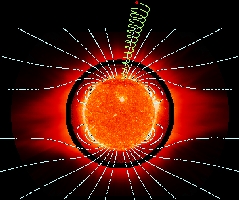These combined images display UV light emitted by the the solar corona on 17 August 1996. The solar disk image is from the EIT instrument aboard SOHO, and the extended solar corona (outside the black ring about 0.5 solar radii from the disk) is from the UVCS instrument aboard SOHO. The color in the latter image represents the total UV intensity emitted by highly ionized oxygen atoms (O VI, or O 5+) in the corona.
The blue-white rays are lines of magnetic force from a theoretical model of the magnetic field of the Sun at the minimum of solar activity (the model was created by M. Banaszkiewicz, W. I. Axford, and J. F. McKenzie). The polar ``coronal holes'' (dark regions on the solar disk) are believed to connect with primarily open magnetic field lines that expand into the high-speed component of the solar wind. In the extended corona viewed by UVCS, the density of particles is so low that individual ions very rarely collide with other particles, and thus they execute spiraling motions around the magnetic field lines (see green curve for an illustration of an example particle's motion).
The transverse spiraling velocities are detected in the broad spectral emission lines seen by UVCS. Surprisingly, UVCS found that the gyration speeds of the ionized oxygen atoms are significantly higher than those of lighter particles like hydrogen; this has crucial ramifications for theories of the heating of the solar corona and the acceleration of the solar wind. So far, the only known theoretical explanation for the faster oxygen spiraling (and for the faster oxygen outflow) is that these particles absorb energy from high-frequency (short period) waves in the solar wind. These waves must have periods of about a millisecond for the particles to be able to sap their energy. In contrast, most of the observed waves in the solar wind have periods of more than a few seconds, up to minutes and hours. The UVCS observations are thus suggestive evidence for the production of these shorter period waves in the solar corona.
Downloads
- Full-size image [JPG, 197K]
- Medium-size image [JPG, 41K]
- Hi-resolution size image [TIF, 298K]
- Medium-size image [JPG, 41K]



